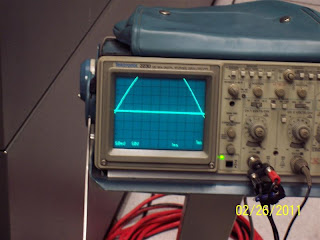Attendees: Ron Williams, Bob Erickson, Stan Paddock, Ed Thelen, Jim Hunt, Ron Crane
Visitors: Goerner, Matthias (one of our 1401 volunteers) brought in two visitors. After visiting us, they went into the main exhibits and were there until the museum staff told them they had to leave since the museum was closing. Ed Thelen provided automobile transportation to and from the Museum for the three of them.
We also had four museum visitors who found our door open and came in to see what was going on.
They got the informal briefing on the equipment in the room.
============================================
Ron Crane has been studying the 'power factor' for the input power on the German machine. The top picture is a test setup where high voltage capacitors were connected to verify the amount needed to correct the power factor.
To measure the power factor, the current through a leg of the three phase power is connected to an oscilloscope along with the voltage. If they both peak at the same time, you have the desired power factor of 1.
We ran tests on the power going into the Connecticut machine and the German machine. The results are shown below.
| German IBM 1401, 1402, 1403, 1406, (1) 729 | 220/380 3Ǿ 50 Cycles | 10.85 | 2,387.00 | 53.06% |
| 220/380 3Ǿ 50 Cycles | 7.05 | 1,551.00 | 34.47% | |
| 220/380 3Ǿ 50 Cycles | 2.55 | 561.00 | 12.47% | |
| Total of three phases | 20.45 | 4,499.00 | 100.00% | |
| Connecticut IBM 1401, 1402, 1403, 1406, (3) 729 | 120/208 3Ǿ 60 Cycles | 14.77 | 1,772.40 | 34.37% |
| 120/208 3Ǿ 60 Cycles | 12.20 | 1,464.00 | 28.39% | |
| 120/208 3Ǿ 60 Cycles | 16.00 | 1,920.00 | 37.24% | |
| Total of three phases | 42.97 | 5,156.40 | 100.00% |
We suspect the power factor shift is related to the unequal loading of the three phases of power going into the German 1401. Research continues.
Bob Erickson is continuing to bring the IBM Model B transmitting typewriter back to life. We were able to get a new typewriter ribbon for the machine and installed it. When we plugged it in and tried to type, no ink transferred to the paper. At lunch, Bob figured out the primary problem. The nearest 110V socket to where the typewriter is located is on the back of the German 1401. That machine runs on 50 cycle power not the normal 60 cycle power. So the power roller that drives the print hammers was running at 50/60 normal speed.
After lunch, we plugged it into 60 cycle power and it worked much better. By the end of the day, Bob got almost all of the type hammers to work as designed.
Ron Williams was checking out the basic timing circuits on the German machine.He noticed a waveform that was not correct. While it did not seem to bother the operation of the machine, it was still wrong.
Ron and Jim Hunt found the card suspected of causing the problem. Jim replaced the transistor and the signal got worse! The question of what 'new' transistor matched the functionality of the old transistor spiked the interest of Ron Crane. The second picture shows Ron Crane testing available transistors to see if he can match the functionality.
Keypunch # 3 miss fed another card again while Bob Erickson and I were watching. It does this about one time out of a hundred. Bob and I took the feed mechanism apart and replaced the feed knives with feed knives from the keypunch carcass. Appears to work fine now.
When I arrived to the Computer History Museum on Saturday, I could not access the external employee door or the two doors into the 1401 Restoration lab. I had to get Museum staff to bring a key and unlock the two doors to the 1401 Restoration lab. We left the doors blocked open all day since we could not get back in if we closed them over lunch. We have been told that this issue is being addressed.
Stan Paddock





















